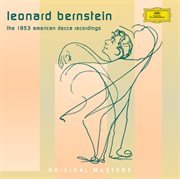Bernstein: the 1953 american decca recordings
(2006)
eMusic
Details
PUBLISHED
[United States] : DG : Made available through hoopla, 2005
DESCRIPTION
1 online resource (1 audio file (6hr., 19 min.)) : digital
ISBN/ISSN
0028947700029 (sound recording : hoopla Music) MWT10948843, 10948843
LANGUAGE
English
NOTES
Mode of access: World Wide Web
CONTENTS
1. Allegro con brio
(00:14:39) -- 2. Marcia funebre (Adagio assai)
(00:17:47) -- 3. Scherzo (Allegro vivace)
(5:39) -- 4. Finale (Allegro molto)
(00:12:10) -- "Simplicity itself..." (1st movement)
(00:13:25) -- "I always feel this gigantism" (2nd movt.)
(6:07) -- "We have just been examining..." (3rd movt.)
(5:26) -- "All that we have said" (4th movt.)
(9:12) -- "The study of the Eroica is a lifetime work,..."
(1:06) -- 1. Adagio - Allegro molto
(8:52) -- 2. Largo
(00:13:33) -- 3. Scherzo (Molto vivace)
(7:16) -- 4. Allegro con fuoco
(00:11:26) -- 1. "Does this music sound like the New World to you?" (3rd movt., Trio II; 1st movt.)
(9:52) -- 2. "We come now to the second movement, which has a charming melody, ..." (2nd movt.)
(3:22) -- 3. "The third movement is a marvel of ingenuity and deftness" (3rd movt.)
(1:40) -- 4. "And now the last movement. In general I should say that this is the most Slavic of all" (4th movt.)
(5:00) -- 5. "The final claim of those who argue for the New World Symphony as American music, ..." (4th movt.,cont.)
(1:01) -- 1. Sostenuto assai - Un poco piu vivace - Allegro ma non troppo - Con fuoco
(00:12:27) -- 2. Scherzo (Allegro vivace)
(6:58) -- 3. Adagio espresssivo
(00:11:53) -- 4. Allegro molto vivace
(8:14) -- 1. "Robert Schumann has been dead..." (3rd movement, opening theme)
(4:22) -- 2. "To my mind Schumann follows in this tradition"
(1:48) -- 3. "Now let's look at the symphony itself" (1st movement)
(8:39) -- 4. "And so we have arrived at the Allegro section..." (1st movt. cont.)
(6:51) -- 5. "In the marvellous Scherzo that follows..." (2nd movt)
(4:49) -- 6. "But perhaps the greatest beauty..." (3rd movt.)
(7:31) -- 7. "Even in the final movement" (4th movt.)
(5:15) -- 1. Allegro non troppo
(00:11:51) -- 2. Andante moderato
(00:11:53) -- 3. Allegro giocoso - Poco meno presto - Tempo I
(6:07) -- 4. Allegro energico e passionato - Piu allegro
(00:10:49) -- 1. "Brahms' Fourth Symphony in E minor is today ..." (4th movt., opening theme)
(4:45) -- 2. "Our journey begins without introduction..."
(5:15) -- 3. "Do you see now what a symphonic theme is?"
(3:23) -- 4. "Now, think of it - we have so far only had 44 bars of music"
(5:47) -- 5. "Here is that second theme"
(2:42) -- 6. "This brings us to the development section proper"
(9:34) -- 7. And here we are back home, ready for the rehearing of the exposition, ..."
(2:17) -- 8. "So we arrive at the coda"
(3:18) -- 9. "Well, we have had a microscopic look at symphonic method"
(2:12) -- 1. Adagio - Allegro non troppo
(00:18:43) -- 2. Allegro con grazia
(8:14) -- 3. Allegro molto vivace
(9:08) -- 4. Finale (Adagio lamentoso - Andante)
(00:11:17) -- 1. "Now there is a melody, a pure orchestral song..." (1st movt.)
(9:18) -- 2. "Now the development section erupts..." (1st movt. cont.)
(1:58) -- 3. "Now one would think that Tchaikovsky had really exploited the device of scales" (2nd movt)
(1:56) -- 4. "Jumping now to the famous third movement, the great March..." (3rd movt.)
(1:50) -- 5. "Perhaps the most admirable example of this is to be found in the wonderful last movement, ..." (4th movt.)
(3:41) -- 6. "Now I don't want to give you the impression that scales are the only unifying force in this work"
(6:01)







